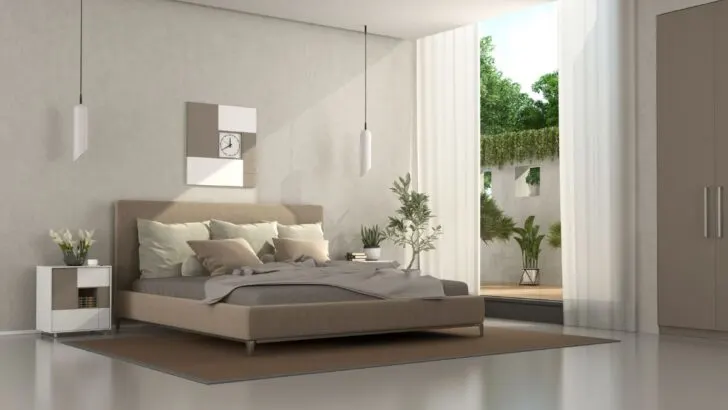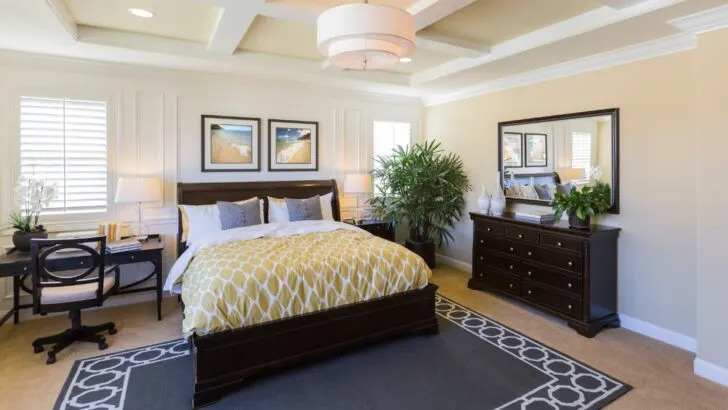Are you wondering what the minimum size for a master bedroom is? It’s an important question to consider when designing or renovating your home.
Your master bedroom is a place where you should be able to relax and unwind, so having enough space is crucial!
The minimum size for a master bedroom typically ranges between 200 and 250 square feet, though this can vary based on local building codes and personal preferences. However, it is generally recommended that the master bedroom be at least 12 feet by 12 feet to allow for a comfortable layout and adequate storage space.
When it comes to the minimum size for a master bedroom, there are several guidelines to consider.
In this article, I’ll explore the different factors that can impact the size of your master bedroom, as well as some general guidelines to help you determine the right size for your space.
Table of Contents
If you were curious about how big a master bedroom should be, learn everything you need to know in this comprehensive guide.
Minimum Size Requirements
When it comes to the minimum size for a master bedroom, there are a few factors to consider. These include:
Factors Affecting Minimum Size
- The size of the bed
- The amount of furniture you plan to have in the room
- Whether or not you plan to have an ensuite bathroom or walk-in closet
However, keep in mind that these factors can vary greatly from person to person, so what works for one person may not work for another!
National and International Standards
There are also national and international standards that dictate the minimum size for a bedroom.
According to the International Residential Code, a bedroom must have a minimum floor area of 70 square feet and a minimum horizontal dimension of 7 feet in any direction.
However, it’s important to note that these are just minimum requirements and may not provide enough space for a comfortable and functional master bedroom.
It’s recommended that you aim for a master bedroom that is at least 200 square feet in size, which will allow for a king-size bed and additional furniture.

Design Considerations
Furniture and Storage
When designing your master bedroom, consider the furniture and storage options that will best fit your needs.
A king-size bed is a popular choice for a master bedroom, but make sure to measure your space to ensure it will fit comfortably.
You may also want to consider adding additional seating, such as a loveseat or armchair, and a dresser or chest of drawers for storage.
Lighting and Ventilation
Good lighting and ventilation are essential for a comfortable and functional master bedroom.
Consider adding a ceiling fan or air conditioning unit for temperature control, and make sure to have adequate lighting for reading, getting dressed, and other activities.
You may also want to consider adding dimmer switches to your lighting fixtures for a more relaxing ambiance.
Privacy and Comfort
Privacy and comfort are important factors to consider when designing your master bedroom. Make sure to choose window treatments that offer both privacy and natural light, such as blinds or curtains.
You may also want to consider adding a soundproofing system to reduce noise from outside sources.
Additionally, consider the color scheme and materials used in your bedroom to create a calming and comfortable environment.
Conclusion on the Minimum Size For A Master Bedroom
When it comes to determining the minimum size for a master bedroom, it ultimately depends on the size of your home and your personal preferences. However, based on the research, a master bedroom should be at least 14 x 16 feet for a house measuring 2,000 square feet and above.
If you have a smaller home, such as an apartment or a house measuring 1,000 square feet, a master bedroom of at least 12 x 15 feet would be suitable. For a larger home above 3,000 square feet, a primary bedroom of at least 350 square feet would be appropriate.
It’s important to keep in mind that the minimum size requirements are just that – minimums. You may prefer a larger master bedroom to accommodate a king-size bed, additional furniture, or simply more space to move around.
Ultimately, the size of your master bedroom should be based on your specific needs and preferences. Consider factors such as the size of your home, your budget, and your lifestyle when determining the ideal size for your master bedroom.
If you found this guide helpful, make sure to take a look at my other guides about master bedrooms below!
What Is the Average Master Bedroom Size?
How Does the Size of a Master Bedroom Affect the Resale Value of a Home?


